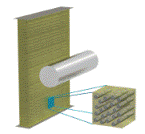Mechanical & Materials Engineering, Department of
Date of this Version
11-2010
Abstract
Complex nanostructured materials have great potential for applications in many areas of nanotechnology. This potential is being unlocked by precise control of their nanoscale architecture and properties. Most current methods of creating these nanostructures are expensive and difficult to control, with the majority of techniques resulting in non-continuous nanostructures and nanoparticles. Electrospinning is an economic nanomanufacturing method resulting in continuous nanofibers. The method consists of spinning fiber-forming liquids in high electric fields. In this work, a modified electrospinning process was analyzed. The process utilized two concentric liquids that resulted in integrated continuous hollow or composite nanofibers. A new adjustable co-axial spinneret nozzle was developed to provide greater control of the nanomanufacturing process. The nozzle was used to manufacture continuous hollow one-dimensional (1D) nanostructures from several materials. The resulting nanostructures were observed and characterized by optical and electron microscopy. Process parameters effecting nanofiber dimensions were identified and their effects were analyzed in extensive systematic parametric studies. The results provide new insight into co-axial electrospinning and can be used for better control of the nanomanufacturing process and nanofibers. Integrated creation of more complex continuous 1D nanostructures that have never been produced before was explored by further process modifications. The challenges of creating such structures where identified for future investigation to succeed.


Comments
A Thesis Presented to the Faculty of The Graduate College at the University of Nebraska In Partial Fulfillment of Requirements For the Degree of Master of Science, Major: Engineering Mechanics, Under the Supervision of Professor Yuris Dzenis. Lincoln, Nebraska: November, 2010
Copyright 2010 John Hannappel